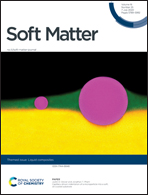Uniform conductivity in stretchable silicones via multiphase inclusions†
Abstract
Many soft robotic components require highly stretchable, electrically conductive materials for proper operation. Often these conductive materials are used as sensors or as heaters for thermally responsive materials. However, there is a scarcity of stretchable materials that can withstand the high strains typically experienced by soft robots, while maintaining the electrical properties necessary for Joule heating (e.g., uniform conductivity). In this work, we present a silicone composite containing both liquid and solid inclusions that can maintain a uniform conductivity while experiencing 200% linear strains. This composite can be cast in thin sheets enabling it to be wrapped around thermally responsive soft materials that increase their volume or stretchability when heated. We show how this material opens up possibilities for electrically controllable shape changing soft robotic actuators, as well as all-silicone actuation systems powered only by electrical stimulus. Additionally, we show that this stretchable composite can be used as an electrode material in other applications, including a strain sensor with a linear response up to 200% strain and near-zero signal noise.

- This article is part of the themed collection: Liquid Composites


 Please wait while we load your content...
Please wait while we load your content...
